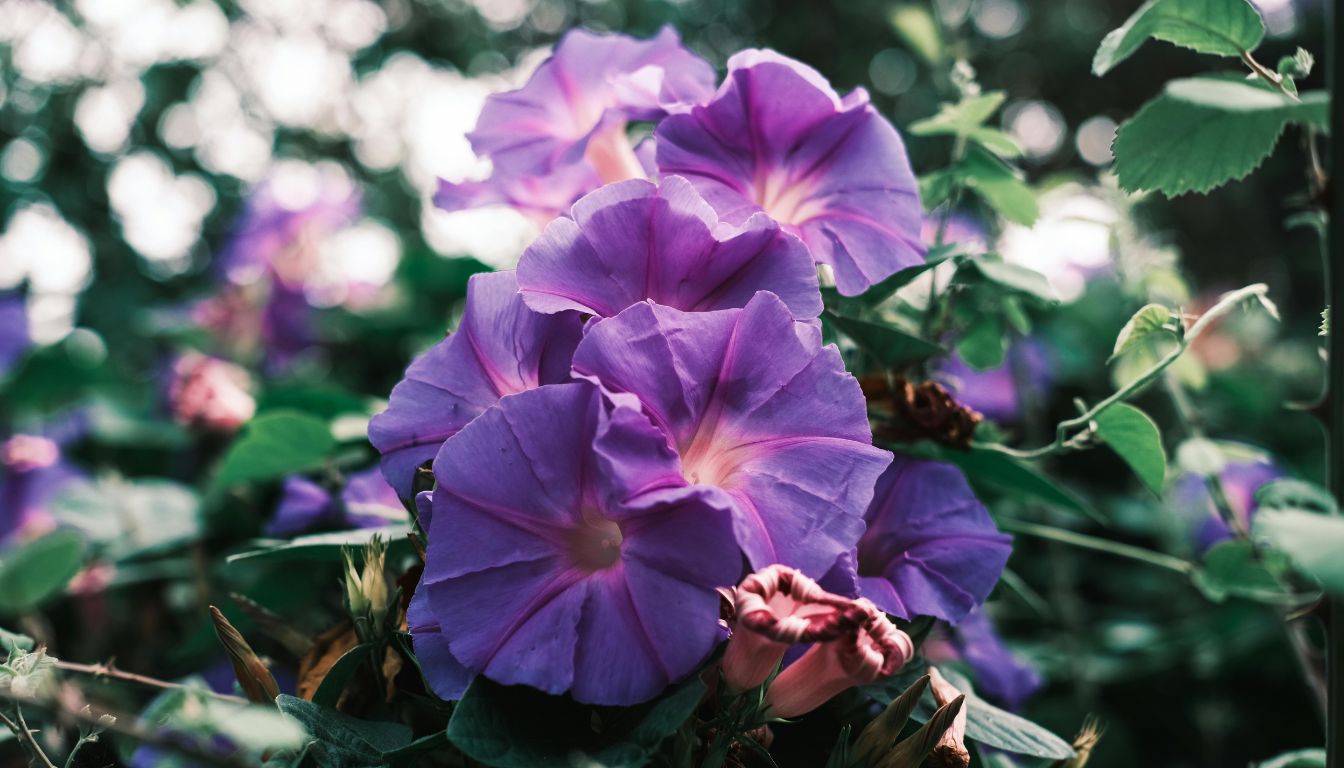If you’re looking to add a splash of color to your garden, Morning Glories are a fantastic choice. These vibrant flowers not only bloom beautifully but also grow quickly, making them perfect for both novice and seasoned gardeners. Imagine waking up to a garden filled with stunning blue, purple, or pink blooms that unfurl with the morning sun.
Growing morning glories is easier than you might think. With just a little knowledge about their needs and some simple steps, you can cultivate a lush display that’ll have your neighbors admiring your green thumb. So let’s dive into the world of morning glories and discover how to transform your garden into a breathtaking floral paradise.
Understanding Morning Glory
Morning glories bring vibrant colors and charm to my garden. Their lively blooms and rapid growth make them a delightful addition for anyone who loves flowers.
Types of Morning Glory – How to Grow Morning Glory: Guide to Vibrant Garden
I enjoy several types of morning glories. Each type has its unique appeal. Here are some popular varieties:
- Ipomoea purpurea: Also known as common morning glory, it features stunning purple flowers. This variety attracts pollinators like bees and butterflies.
- Ipomoea nil: Known as Japanese morning glory, it offers intricate blooms in various colors. Its unique patterns add beauty to any trellis or fence.
- Ipomoea batatas: The sweet potato vine boasts heart-shaped leaves. I love using its foliage for a lush background while enjoying edible tubers.
- Ipomoea alba: This white morning glory blooms at night. Its sweet fragrance enchants my evenings in the garden.
Each type adds its flair, making it easy to choose one that matches my garden style.
Benefits of Growing Morning Glory
Growing morning glories comes with many benefits. First, their fast growth provides quick satisfaction. I love watching them climb and spread over structures in my yard.
Second, morning glories require minimal maintenance. They thrive in sunny spots and adapt to various soil types. Once established, they don’t demand much attention, allowing me to focus on other plants.
Third, these flowers attract beneficial insects. Bees and butterflies flock to their vibrant blooms, enhancing my garden’s ecosystem.
Finally, morning glories can serve as natural privacy screens. I appreciate how they can hide unsightly structures while adding beauty.
Overall, morning glories are a fantastic choice for adding color and charm to any garden space.
Preparing for Planting

Getting ready to plant morning glories is crucial for a successful garden. I focus on a few key elements, making the process straightforward and enjoyable.
Choosing the Right Location – How to Grow Morning Glory: Guide to Vibrant Garden
Light is everything for morning glories. I seek spots that receive full sun for at least six hours daily. This plant thrives on sunlight, so I find a sunny wall or fence that’s eager for some floral company. Avoid placing them in shady areas. They’ll get leggy and unhappy. I also watch for wind exposure. Morning glories can grow tall, so I check that they’re not in a windy pathway. Safety first, even for plants!
Soil Requirements
Soil matters to morning glories, too. I ensure the soil drains well. These plants dislike sitting in water like it’s a cozy hot tub. Loamy or sandy soil suits them just fine. I also keep the pH between 6.0 and 7.0. This balance helps them flourish. If needed, I test the soil ahead of time and amend it with compost. Healthy soil equals happy plants. I don’t skip this essential step.
Planting Morning Glory
Planting morning glories is straightforward and exciting. These flowers add a cheerful touch to gardens with their vibrant colors and swift growth.
Seeds vs. Transplants – How to Grow Morning Glory: Guide to Vibrant Garden
Deciding whether to use seeds or transplants impacts your garden’s success. Using seeds is a budget-friendly option. I drop seeds directly into the prepared soil after the last frost date in my area. Space them about six inches apart to give them room to flourish. If you’re impatient or want larger blooms sooner, transplants are a great choice. I visit a local nursery to pick up healthy young plants, usually around six inches tall. Both methods yield beautiful results, so choose what suits your style best.
Planting Techniques
I find that planting morning glories involves a few key techniques for the best growth. First, I dig holes about an inch deep and place the seeds or transplants inside. Cover them gently with soil, then water well without flooding. Watering helps the seeds or roots settle in nicely. I avoid compacting the soil too much; air needs to flow! Utilizing garden stakes or trellises gives these vines a place to climb and show off their stunning blooms. Make sure to position them in full sun to soak up all those rays and produce a bountiful display. Enjoy the process; watching them grow brings a sense of joy and accomplishment.
Caring for Morning Glory

Caring for morning glory ensures a vibrant display in the garden. Following simple practices keeps these beauties flourishing.
Watering Guidelines – How to Grow Morning Glory: Guide to Vibrant Garden
Water morning glories consistently, especially during dry spells. Soil should stay moist but not soggy. I often water the plants every three to seven days, depending on the rain. Avoid wetting the leaves to reduce the risk of mildew. If your mornings lack moisture, don’t fret, these resilient plants bounce back quickly.
Fertilization Tips
Fertilizing morning glories helps boost growth and blooms. I recommend using a balanced fertilizer with equal parts nitrogen, phosphorus, and potassium. Apply it every four to six weeks during the growing season. Too much fertilizer can lead to lush leaves but fewer flowers. Remember, morning glories thrive on neglect, so less sometimes means more.
Pest and Disease Management
Watch for pests like aphids or spider mites. I check the undersides of leaves regularly. If I spot pests, a gentle spray of water usually does the trick. For stubborn infestations, insecticidal soap works wonders. Keep an eye out for signs of powdery mildew too. Good airflow around the plants helps prevent this issue. If it appears, trimming affected leaves immediately reduces its spread.
Common Challenges
Growing morning glories can come with its fair share of challenges. Identifying and addressing these issues keeps my garden flourishing.
Troubleshooting Growth Issues – How to Grow Morning Glory: Guide to Vibrant Garden
Leggy growth often happens when morning glories don’t get enough sunlight. They stretch towards light sources, leading to weak stems. I make sure to plant them in areas that receive full sun for at least six hours a day. Poor soil drainage can also hinder growth. If the ground stays soggy, roots may rot. I use well-draining soil and mix in compost, ensuring my plants thrive. For some reason, pests like aphids and spider mites sometimes invade. Regularly checking for them allows me to address infestations quickly using insecticidal soap or a strong water spray.
Seasonal Considerations
Seasonal changes can impact Morning Glory’s health and growth patterns. Frost can kill young plants, so planting occurs after the last frost date in my area. During the summer heat, I keep an eye on watering. Morning glories appreciate consistent moisture but dislike soggy roots. I adjust my watering schedule according to the season, ensuring their soil stays just right. In the fall, I often see them start to fade. In my experience, cutting back on watering helps them prepare for winter. These little adjustments can help me enjoy vibrant blooms season after season.
Before You Go – How to Grow Morning Glory: Guide to Vibrant Garden

Growing morning glories can truly transform your garden into a vibrant oasis. With their stunning blooms and rapid growth, they’re a delightful addition for any gardener. I’ve found that with the right care and attention, these beauties can thrive and bring joy throughout the growing season.
Remember to choose the ideal location and maintain consistent care to ensure your morning glories flourish. Don’t hesitate to experiment with different varieties to find the ones that resonate with your garden’s style. Embrace the process and enjoy the beauty that morning glories can bring to your outdoor space. Happy gardening!
Don’t forget to add theherbprof.com homepage to your favourites so you don’t miss out on future articles.
References – How to Grow Morning Glory: Guide to Vibrant Garden
Little Herb Encyclopedia, by Jack Ritchason; N.D., Woodland Publishing Incorporated, 1995
The Ultimate Healing System, Course Manual, Copyright 1985, Don Lepore
Planetary Herbology, Michael Tierra, C.A., N.D., Lotus Press, 1988
Handbook of Medicinal Herbs, by James A. Duke, Pub. CRP Second Edition 2007
The Complete Medicinal Herbal, by Penelope Ody, Published by Dorling Kindersley
Check the Following Articles
Bucket Gardening: Herbs and Veggies in Small Spaces
Grow Stunning Red Peonies to Transform Your Garden
Growing Indoor Avocado Tree: Tips and Care Guide
Growing a Basil Bush: Tips for Flavorful and Thriving Plants
Frequently Asked Questions – How to Grow Morning Glory: Guide to Vibrant Garden
What are morning glories?
Morning glories are vibrant flowering vines known for their fast growth and stunning blooms. They are suitable for gardeners of all experience levels and can significantly enhance the beauty of any garden.
What types of morning glories are there?
There are several types of morning glories, including Ipomoea purpurea (common morning glory), Ipomoea nil (Japanese morning glory), Ipomoea batatas (sweet potato vine), and Ipomoea alba (white morning glory), each with unique characteristics.
How do I prepare for planting morning glories?
Select a sunny location that receives at least six hours of sunlight daily and ensure the soil is well-draining, loamy or sandy, with a pH between 6.0 and 7.0. Amending the soil with compost is also advisable for healthy growth.
Should I use seeds or transplants for morning glories?
You can use either. Seeds are cost-effective and can be directly sown after the last frost, while transplants bloom sooner. Choose based on your preference and gardening timeline.
What are the care tips for morning glories?
Maintain consistent watering during dry periods without saturating the soil. Apply balanced fertilizer every four to six weeks. Regularly check for pests and ensure adequate airflow to reduce the risk of powdery mildew.
What challenges might I face when growing morning glories?
Common challenges include leggy growth from insufficient sunlight and root rot due to poor soil drainage. Monitor pest activity and adjust watering based on seasonal changes for optimal plant health.

